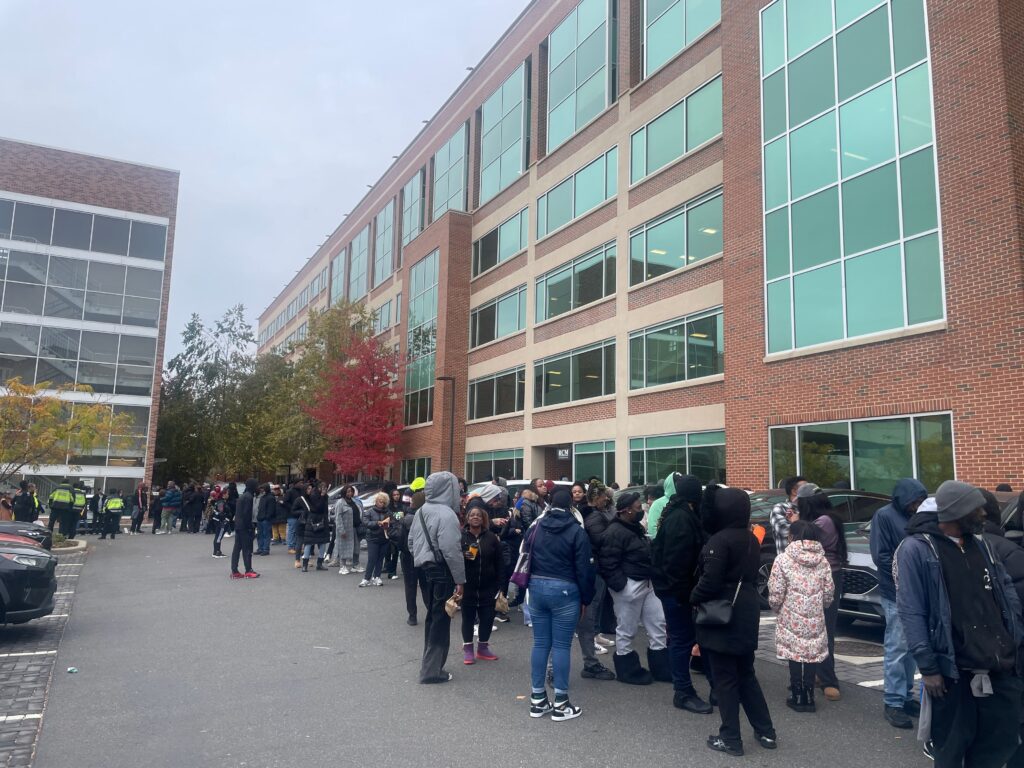The line snaked out the door, down the sidewalk, into the parking lot — men and women and children and the elderly, hundreds of D.C. residents who arrived at the city’s family resource center for a shot at emergency rental aid.
Markisha Drake sat inside the parking garage stairwell nearby, rocking her 4-month-old bundled in a pink blanket and tiny coat inside her car seat, trying to get her to sleep. She had brought 10 diapers, a whole pack of wipes and four bottles of milk, Drake said, and at the rate the line was moving she wasn’t sure how long the bottles would last. “She’s a little cranky right now,” she said, “and I get it, because she’s not used to being outside this long.”
Like the more than 700 people who had shown up that morning, some as early as 6 a.m., Drake was behind on rent. The backlog started when she quit her job as a concierge while she was pregnant, when hyperemesis — severe, sustained nausea that hits some women during pregnancy — became unbearable, keeping her from going to work. The hole kept growing, despite subsidized rent covering two-thirds of her payments. Now she was $7,000 behind, and there was an eviction notice on her door.
The number on the yellow ticket in her pocket was 392 — with 391 people in front of her all seeking an appointment with the D.C. Department of Human Services to apply for emergency rental assistance. There probably wouldn’t be enough money to go around. The Emergency Rental Assistance Program (ERAP), intended to give limited aid to people who could face eviction due to unexpected challenges in their lives, sustained large budget cuts this year — down to $8.6 million from more than $26 million.
But the high demand hadn’t seemed to change.
“I’m praying,” said Drake, 26. “They said they was going to help all of us out here. So I’m hoping they do that before, you know, this building closes at 4:45.”
The hundreds-strong queue outside the Virginia Williams Family Resource Center on Thursday offered a snapshot of hardship that Washingtonians living on the margins have been facing — the choices between paying rent or food or car notes and the limitations of the safety net to keep the city’s poorest residents from eviction. ERAP has been seen as a Band-Aid solution to housing stability by many in city government; one-time aid that residents can’t rely on or expect to receive given the enormous demand. But advocates say it’s also a critical lifeline for those facing eviction who may have nowhere else to turn.
“We’re all just one check away, you know?” said Janiya Marshall, a 26-year-old college student who had been affording rent without a problem until losing her job as a concierge in July, falling $5,000 behind.
Because of the limited funds and skyrocketing demand, DHS closed applications for ERAP last November after accepting applications for a single day. Thursday marked the first time residents could seek rental aid again.
But this time, rather than using an online portal, they would have to schedule an in-person appointment, either by calling DHS or showing up at the resource center. A DHS spokesman said in a statement the switch to requiring in-person appointments was intended to “increase transparency, improve eligibility verification and better manage limited program funding.”
The doors and the phone lines opened at 9 a.m.
The phones went down, unprepared for the volume of calls. The line was punishingly long.
Police stood outside the door and loitered in the parking lot. Socialist activists handed out hand warmers and granola. Some who were disabled or who had young children were at first given preference, but after several hours even those groups grew large. Many in line said they didn’t understand how the D.C. government had failed to create a sensible process to submit an application.
“We’re all cold. We’re all hungry. I just want a snack,” Kaylla House, 23, who had been in line for about five hours, said as she inched toward the front.
The people in line quieted down as a DHS staff member with a bullhorn tried to deliver an update, his voice traveling no further than the first several dozen weary waiters.
“You will get an ERAP appointment today,” he bellowed. “Everyone in this line will get a number.”
Some had taken off work to be there, from low-wage jobs that weren’t enough to pay the rent.
Vernoica Davis, 36, said that a slowdown in the restaurant industry meant she was pulling in less than half of what she used to make waiting tables at Carmine’s. Her car got repossessed. Now the landlord wanted her apartment back, too.
Nekaybaw Jackson, 28, works the overnight shift for Amazon, 1:20 a.m. to 11:50 a.m., Friday through Monday, and works as an aide for disabled people from 2 p.m. to 10 p.m. Monday through Friday — a second job she picked up recently. But that also put her over the income limit for food stamps for her and her two kids. And while she has a housing voucher covering a portion of rent, she said, she comes up a bit short at the end of the month. She has an $840 gap to fill.
Many others in line were in the throes of unemployment, struggling to compete in the job market as landlords ran out of patience. Chanelle Washington, 32, said she lost her job helping high-schoolers prepare for college in August. Now, she said, it was hard to justify making the payments with what little she had at her disposal when her place was infested with roaches and the landlord wasn’t fixing the problem.
Deon Johnson, 36, moved to D.C. from Dallas in February to take a job as a program analyst at the National Institutes of Health, which he got through the federal government’s prestigious presidential management fellowship — only to be immediately laid off, along with thousands of other employees. A court ordered he and others be rehired, only for the Trump administration to fire him again in July.
Johnson tapped retirement funds to pay his rent in August and September. He didn’t pay in October or November. He has applied for about 60 positions at nonprofits and in higher education — the field in which he attained a PhD in 2022. It was farther than anyone in his family had gone before. He grew up poor, he said, and now, standing for six hours in the cold to apply for government aid, he felt like he was right back where he began. It was “humbling,” he said.
“Having grown up in poverty, getting to upper middle class, going back to poverty, it’s been like … wow,” he said. “Everything turned into a nightmare.”
Back in the stairwell, Drake changed her baby’s diaper on her lap and fed her some more milk. Outside, a man in line noticed her through the window and came in to check on her.
“Did you try to go up there?” he said, wondering whether they’d let Drake and her baby through the front of the line. She had tried that, she said. It didn’t work.
The man, a stranger, said to wait — he would go try to find help for her again. He peeked at the infant trying to fall asleep in her blanket.
“I got three bottles left,” Drake said.
The post Hundreds of struggling renters in nation’s capital line up to ask for help appeared first on Washington Post.




